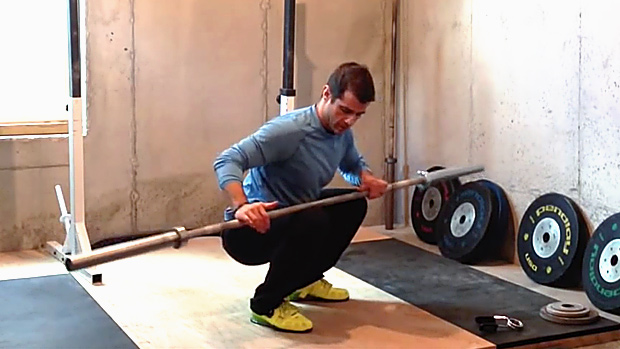Here's what you need to know...
- If you're an athlete or a lifter, chances are your shoulders have given you some trouble. In fact, no other body part is as prone to dysfunction.
- Movement is king. Where crisp, clean movement is found, the ability to train without pain is soon to follow.
- You can access your own movement with self-diagnostic testing, then rid your shoulders of nagging pain.
When it comes to strength training and fitness, there may be no region in the body that's as chronically dysfunctional and painful as the shoulder complex.
Simply put, the four joints comprising the shoulder girdle are battle-tested on a daily basis, not only in training but also sports like desk jockeying and frantic finger pounding into your smart phone (which are both up for review to be added to the 2020 Olympic Games.)
This region is termed the shoulder "complex" for a reason – mostly due to the insane complexity of the soft tissues that encompass multiple joints all working together to elicit smooth and powerful movements in coordination with the rest of the body.
Even with advanced orthopedic evaluation, the likelihood of even the most talented sports medicine specialist pinpointing the exact origins of pain with palpation alone is about as likely as that snowball's chance in hell you've heard about.
One thing holds true: Movement is, and will always be, king. Where crisp, clean movement is found, the ability to train without feeling like you're being impaled by ice picks every time you bench is soon to follow.
These days, assessing posture in my physical therapy practice has become a useless waste of time. No matter if we're evaluating an elite overhead athlete that cashes million dollar checks or an overweight mother of four, one thing holds true: their postures are atrocious.
Computers and smart phones aren't going anywhere soon. The posture of the general public is going to get worse. But athletes, lifters, and fitness fanatics are still going to move.
Assessing shoulder mobility and movement patterns with just a few simple screens can largely influence whether they move well while continuing to move often.
All you need is your own body, a mirror, and the willingness to stare at yourself shirtless without a pump.

The ball and socket type shoulder complex has the ability to move within the three cardinal planes of motion, making it one of the most mobile joints in the body.
Wide ranges of movement capabilities also make the shoulder joint more susceptible to injury, especially when lifters are pushing their bodies to the absolute limits in both hypertrophy and strength.
It's important to know and appreciate the movements of the shoulder joint in order to screen yourself for possible mobility impairments and movement dysfunctions. Here are the three cardinal planes of motion and the movements the shoulder is capable of using within these planes:








Remember, we aren't cyber-kinetic organisms. We have the capability to coordinate smooth movements in all planes of motion simultaneously.
This makes the isolated shoulder movements described above all but obsolete, especially for assessing your own movement with self-diagnostic testing with goals of corrective movement and ridding your shoulders of nagging pain.
Screening functional internal and external rotation of the shoulder joint can play a huge role in not only identifying mobility deficits, but also identifying painful local areas within the shoulder complex.
The term "functional" doesn't mean we're going to test mobility while flailing around on a physio-ball. It simply refers to a combination movement that correlates more specifically to coordinated movements of the shoulder complex as a whole.
Functional internal and external rotation can be described as the combination of three distinct shoulder movements all performed in conjunction with smooth and rhythmical movement patterns in a certain range of motion.
Here are the breakdowns of both of these functional mobility tests:


These movements can be tested unilaterally or in reciprocal fashion. First thing's first: Get both arms moving simultaneously while in a standing position.
The Apley's Scratch Test will show how both shoulder girdles work in coordinated movement along with mobility capabilities of each of the shoulder girdles separately.
The right will be moving into functional internal rotation while the left is moving into functional external rotation all at the same time. The goal is to try and approximate the fingertips of each hand to touch behind your back while being symmetrical from shoulder-to-shoulder when both sides are tested.
No cheating on this one by breaking neutral posture at the spine or ratcheting your hand up your back little by little.
Take into account the distance between your hands for both sides moving through functional internal rotation and external rotation at the same time. Also note any pain or movement differences from side to side.
What you feel internally is the most important aspect of this test, with the coordinated dual shoulder range of motion a close second.

If after completing the Apley's Scratch Test and finding asymmetrical movement, pain, or notable mobility deficits (your fingers not even close to touching), it's time to break the functional movements down to identify where the faulty movement is originating.
By moving one arm at a time, the thoracic spine and ribcage are largely taken out of the mobility equation.
While moving both arms reciprocally during the Apley's Scratch Test, the thoracic spine is also being tested in how well it's able to coordinate a stable extended position while the shoulder girdles are approximating end-range motion. This leaves us able to focus in on the shoulder movement itself.
Screen one shoulder at a time in both functional internal and external rotation. While moving into functional external rotation, the goal is to be able to touch your fingertips to the bony spine of the contralateral shoulder blade.
As for the functional internal rotation screen, touching your fingers to the inferior angle of the shoulder blade on the opposite side shows normal mobility within that pattern.
The testing positions are the same as the pictures above showing proper functional internal and external rotation.
Chances are, when you broke down the test into one shoulder moving at a time, your range of motion, along with the rhythm of the movement, was notably better. If so, your shoulder pain may be secondary to poor thoracic spine mobility.
This is a great finding because you're well on your way towards taking action steps in your p/rehabilitation program. Focus on these three thoracic spine mobility drills before and after your training:
Now that we have some metrics on the amount our shoulders are moving through functional internal rotation both reciprocally and unilaterally, it's time to assess rhythm and coordination.
As your shoulder moves into elevation, a few things must happen in order to complete a full and pain-free range of motion to end range. First, all joints of the shoulder complex must be working together, but also kicking in at advantageous times.
An asymptomatic shoulder joint with normal range is usually able to get to about 180 degrees of motion at end range. Obviously every shoulder girdle is as unique as the person it's connected to, so this is a ballpark number.
For the shoulder to move through this range without compensation patterns dominating the movement, the shoulder blade and humerus (bone of the upper arm) must be moving in synergistic and rhythmical fashion. We call this scapula-humeral rhythm.
Pristine scapula-humeral rhythm simply means that for every 2 degrees of motion the humerus moves into elevation, the shoulder blade must upwardly rotate 1 degree of motion to achieve end range.
However, the numbers don't tell the entire story. The point at which the shoulder blade starts to kick in is also very important.
When assessing your own scapula-humeral rhythm, it's important to not only look at ranges of motion, but also when the shoulder blade starts to move.
At approximately 120 degrees of upper arm elevation, the shoulder blade should just be starting to upwardly rotate. If you find your shoulder blades become highly visible at the sides of your body before 120 degrees while slowly moving your arms into elevation, this is indicative of posterior shoulder soft tissue tone and tightness.
Also, assess the symmetry of the movement from left to right. Are your shoulder blades starting to rotate at the same times, or is the rhythm off and asymmetrical?
If your rhythm is off, your best course of action is to start in on a posterior shoulder girdle soft tissue and mobility program.
This can simply be movement targeting the latissimus dorsi and other surrounding muscles with foam rolling or Hands-On SMR, or mobility focused movements such as loaded stretches into your programming.
The choice is yours, and the only wrong decision is to not address these issues at all.
Finally, if you nerd out on mechanics of human movement and dysfunction, you most likely want to figure out what exact anatomic location in the shoulder complex is causing you discomfort every time you hit the gym.
Let's go back to the scapula-humeral rhythm testing position and switch our focus on pain provocation.
The most commonly injured sites in the shoulder girdle are the gleno-humeral joint (GH-Joint) and the acromio-clavicular joint (AC-Joint). Though these two joints work together in upper extremity function, they're responsible for playing in primary movements at different points of the movement arc into shoulder elevation.

The painful arc of the shoulder states that if pain in the shoulder is present when your upper arm is within 45-120 degrees of motion, the most likely culprit causing pain is within the GH-Joint.
On the other side of the arc, if pain in the shoulder is only present at end range shoulder elevation, between 170-180 degrees, the AC-Joint is likely the portion of the shoulder complex that isn't functioning correctly.
If your own self-diagnostic findings point to GH-Joint pain and dysfunction, enhancing your dynamic and static shoulder positioning, especially under load, is going to be the one of the most efficient ways to leave pain in the dust while continuing to train hard.
As for the AC-Joint, relieving unwanted joint stresses at end range can be avoided by decreasing the tone of the muscles and structures of the posterior shoulder girdle, allowing better tracking patterns of the scapula and shoulder joint as a whole.





